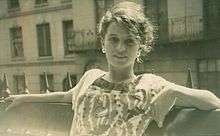Mary White (textile designer)
Mary White later Mary Dening (born 1926) is an English textile designer known for several iconic textile prints of the 1950s.[1][2] Her work could be found in homes across the world, as well as in cabins aboard the RMS Queen Mary and at Heathrow Airport.[3] Her creations are now undergoing a resurgence of interest. She also was a potter and ceramist, and in the 1960s creating Thanet Pottery with her brother David White.[3]
Mary White | |
|---|---|
 Mary White in 1947 | |
| Born | 1926 (age 93–94) Margate, Kent, England |
| Nationality | British |
| Other names | Mary Dening |
| Alma mater | Thanet School of Art and Crafts |
| Known for | Textile design and pottery |
Biography
White was born in 1926,[4] in the town of Margate in Kent, England. She was trained as a textile designer and studied textile design at the Thanet School of Art and Crafts.[3]
Textiles
Mary White enjoyed a huge reputation in the 1950s as one of the leading mid-century fabric, textile and pattern designers of the era. In the 1950s she worked as a textile designer contracted with the design studio of David Whitehead, which included other designers and artists such as John Barker, Afro Basaldella, Eileen Bell, Gerald Downes, J. Feldman, Barbara Pile, Humphrey Spender, Robert Tierney, Lisa Gronwall and Maj Nilsson.[5] White was designing during the same period as British textile designer, Lucienne Day.
To create her designs White drew on the work of William Morris, books of flowers and the countryside where she grew up and has lived throughout her life. In turn her work has influenced leading fashion icons such as Mary Quant, Laura Ashley and Sir Terence Conran.[3] White created hundreds of designs in her career, some of her most famous creations are Coppice, Cottage Garden and Zinnia which were best sellers in leading outlets such as Liberty and Heals. The design Cottage Garden was one of White’s most successful designs. It was made available by Heals in 1955, at a price of 10s 9d per yard, coming onto the market at a time when a greater number of people than ever were accepting "contemporary" design.
White's Coppice patterned textile print was reproduced as a rug and sold in John Lewis as recently as 2010.[6]
Many of White’s designs are exhibited in museums all over the world including the Victoria and Albert Museum in London, the Warner Textile Archive in Essex and the Whitworth Art Gallery in Manchester. Collectors of 1950s fabric continue to collect Mary White material. White's designs continue to be included in books on the subject of 1950s textile design such as 20th Century Pattern Design by Lesley Jackson, design curator, historian and author.
Pottery
White was also involved in Thanet Pottery, having also studied pottery at Thanet School of Art and Crafts. Thanet Pottery was a collaboration between White (then using her married name of Dening) and her brother, David White.[7] Thanet Pottery made hand painted slip cast earthenware pottery and their items were sold to High Street chains in the early 1960s.
Mary White was interviewed and included in the BBC One show The 1952 Show, Episode 2 which aired on 27 March 2012.[8]
References
- "1950s Textile Designer Mary White meets with FashionCapital". Fashion Capital. Archived from the original on 26 February 2015. Retrieved 4 July 2010.
- Zamora, Yoel Morales. "1950's Textile Designer Mary White meets with FashionCapital". Fashion Capital. Archived from the original on 2 February 2018. Retrieved 29 September 2017.
- "Iconic British Textile Designers". Stuart Morris -. 23 May 2014. Retrieved 29 September 2017.
- "Ambleside by White, Mary". V&A Museum Collections. Retrieved 5 June 2018.
- Jackson, Leslie (2007). Twentieth-Century Pattern Design. New York City, New York: Princeton Architectural Press. pp. 103–104. ISBN 1568987129 – via Google Books.
- 1950s-designed Honesty Rug from John Lewis. Retro To Go (2010-03-24). Retrieved on 2013-01-07.
- "Thanet Pottery". studiopottery.com. Retrieved 5 June 2018.
- "Episode 2, The 1952 Show - BBC One". BBC. Retrieved 29 September 2017.
Further reading
- Jackson, Lesley: "Twentieth-century Pattern Design: Textile & Wallpaper Pioneers", page 99 and page 103. Princeton Architectural Press, 2002. ISBN 978-1-84000-371-0.
- Fiell, Charlotte and Peter: "Decorative Art 50s", page 294. Taschen, 2008. ISBN 978-3-8365-0310-5.
